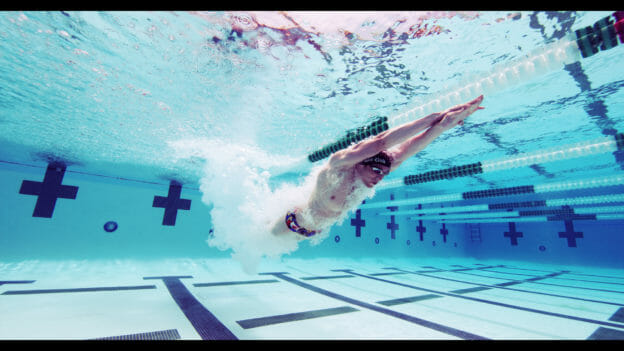Hybrid Freestyle Technique: Who should use it and when?
The Hybrid freestyle technique, also known as the loping or galloping freestyle, is a technique that has been used by some of the most recognized names in swimming; Michael Phelps, Ryan Lochte, Katie Ledecky and Jason Lezak, just to name a few.
In earlier Aquanotes, we discussed the differing features of the three styles or techniques of freestyle, Shoulder-driven (video), Hip-driven (video) and Hybrid freestyle (video). You can refer back to those articles to learn more about the differences in the three freestyle techniques. The question is, who should use a Hybrid freestyle technique and when?
The first swimmer that I recall using a Hybrid freestyle technique was Matt Biondi, who dominated the 100 and 200 freestyle events of the late 1980’s. His long powerful freestyle stroke, coupled with a strong kick, helped propel him to world record times. He would come down faster with his recovering arm after the breath and surge forward with his head underwater to achieve great speeds.
Since Matt, many swimmers have adopted this same technique of using two different arm recovery rates with the breathing and non-breathing sides. After the breath, the swimmer’s arm is driven aggressively to the water and hyperextended forward, similar to a Hip-driven freestyle. On the non-breath side, the arm recovers more slowly, but then the hand immediately presses downward after the entry, similar to a Shoulder-driven freestyle technique. Thus, the name Hybrid freestyle.
Although we see the Hybrid freestyle technique being used from the 100 meters to the 1500 meter events, it is most commonly seen in the middle-distance events of 200 and 400 meters. In fact, most of the elite men swimming the 200 meter freestyle today use the Hybrid freestyle technique. Since the stroke rate of Hybrid freestyle is typically somewhere between the fastest stroke rates of Shoulder-driven freestyle (seen in the 50 meter sprint freestyle) and the slower stroke rates of Hip-driven freestyle (seen more commonly in the distance events), it is not surprising that Hybrid freestyle seems best suited for the middle-distance events.
One thing that all fast Hybrid freestylers have in common is a strong kick. Therefore, if your kick is not strong, it may not be the best freestyle technique for you to use. The strong kick provides for more constant propulsion and really helps surge the swimmer forward, particularly after the breath.
Many Hybrid freestylers do not develop this technique until later in their careers, as their kick becomes stronger. Katie Ledecky is a good example of a swimmer that converted to a Hybrid freestyle prior to the Olympic Games in London at the age of 15 years, where she won the 800 meter freestyle. Prior to that, she used a Shoulder-driven freestyle with a two-beat kick. However, I have seen some young age-group swimmers adopt the Hybrid freestyle well and become very effective at using it.
If you feel your kick is good or has the potential to become strong and you want to learn the Hybrid freestyle technique, we recommend using fins to start with to increase your kicking propulsion. Watch the two important Hybrid drills (video) that we feature in our webisode video series on the Three Styles of Freestyle. Then, once you have become more comfortable practicing the Hybrid freestyle with a stroke rate of around 75-85 per minute, consider using it in your 200 meter freestyle races first. Even sprinter Caeleb Dressel uses a Hybrid freestyle technique in his 200 meter freestyle.
As you become more adept at using Hybrid freestyle, you can consider increasing the stroke rate to 86-90 or above and adopting that technique for the 100 freestyle. Remember that for Hybrid freestyle to work well in the 100 meter event, the kick must be also be stronger.
For the middle-distance events, the Hybrid freestyle is more efficient and energy-conserving than using a faster-stroke-rate Shoulder-driven technique. Yet, Hybrid freestyle has the potential for more speed than the Hip-driven freestyle technique. With a strong kick, we believe that the Hybrid freestyle technique can be an excellent choice of techniques, particularly for the 200 and 400 freestyle events.
Yours in Swimming,
Gary Sr.

